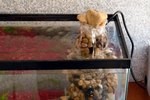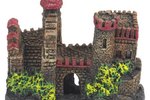Things You'll Need
Oxygenating plants
Waterlilies
Reeds
Irises
Floating plants
Native clams
Long plastic container
Pond filter
Rocks
Sand
Clay
Compost
Clam food
Algae-infested water can be identified by the green cast it leaves throughout the water table, slime on rocks, hairlike organisms within plants and ornaments and the surface of your pond. While some algae growths are perfectly safe and needed for good pond health, an overgrown pond can be dangerous and nasty looking. Keeping a pond or aquarium clear from algae can be a daunting prospect if you are not prepared for the undertaking. Luckily, with a bit of studying and preparation, you can keep algae under control.
Mix enough clay, sand and compost together to form a heavy potting mix. Pot irises, waterlilies and any other rooted plants in the clay mixture in pots made for ponds. There should be open places throughout the pots to allow water flow so the plants can cleanse the water.
Top off each pot with a layer of sand and small pebbles. Insert a fish-safe fertilizer tab in each pot, following the manufacturer’s instructions. Place the plants at their correct planting depth throughout the pond.
Place floating plants such as duckweed in the pond. At least one-third of the water’s surface should be covered with plants. This will shade out algae, and also give fish shelter.
Fill the plastic container with clean sand and soak it with pond water. Leave a rim above the sand level to keep the clams contained. When it is saturated, place several clams end down in the sand. Put the container in a bare area of the pond out of direct light. Avoid planting in the sand.
Install a pump and filter that is large enough for the size of your pond. Avoid placing obstructions like plants or rocks in front of the intake because they may clog the pump.
Tips
General upkeep of the pond includes cleaning out any large debris from the water and filters. Remove any plants that are taking over or becoming a nuisance. Surface-covering, potted and other free-floating plants shade out algae and compete for food. Planting many desirable plants means less algae.
Warnings
Clams need to be fed. They do not eat fish waste or remove ammonia. They are excellent choices for clearing algae from the water, but are not good as a means of real filtration. Feed clams no less than twice a week with a good invertebrate food made for them. Use only native clams in outdoor ponds. Permits may be required to gather them from the wild, so it is best to find someone who already raises them (legally). Many species of invasive clams and mussels (like the golden clam and zebra mussel) are wreaking havoc on North American waterways. These creatures are adaptable and compete with native clams and mussels for food and habitat. It is illegal to release them into the wild. Certain mussels use fish as a host for their young. Though usually not a fatal event, it is best to use freshwater clams that do not go through a parasitic larval stage.
References
Photo Credits
-
Art Wolfe/Digital Vision/Getty Images




